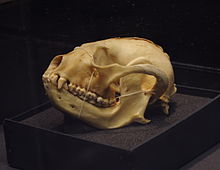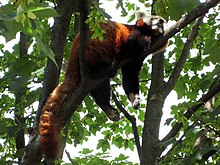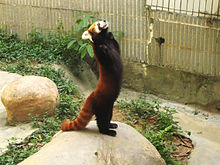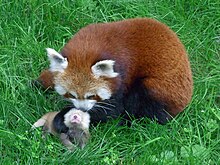Red Panda
Scientific Classification
Kingdom : Animalia
Phylum : Chordata
Class : Mammalia
Order : Carnivora
Family : Ailuridae
Genus : Ailurus
Species : Ailurus Fulgens
Conservation Status

Endangered
The red panda (Ailurus fulgens) is a mammal native to the eastern Himalayas and southwestern China. It is listed as Endangered on the IUCN Red List because the wild population is estimated at fewer than 10,000 mature individuals and continues to decline due to habitat lossand fragmentation, poaching, and inbreeding depression.
The red panda has reddish-brown fur, a long, shaggy tail, and a waddling gait due to its shorter front legs; it is roughly the size of a domestic cat, though with a longer body and somewhat heavier. It is arboreal, feeds mainly on bamboo, but also eats eggs, birds, and insects. It is a solitary animal, mainly active from dusk to dawn, and is largely sedentary during the day. It is also called the lesser panda, the red bear-cat, and the red cat-bear.
The red panda is the only living species of the genus Ailurus and the family Ailuridae. It has been previously placed in the raccoon and bearfamilies, but the results of phylogenetic analysis provide strong support for its taxonomic classification in its own family, Ailuridae, which is part of the superfamily Musteloidea, along with the weasel, racoon and skunk families. Two subspecies are recognized. It is not closely related to the giant panda, which is a basal ursid.
Phylogenetics

(Phylogenetic Tree of Red Panda)
The taxonomic classification of the red panda has been controversial since it was discovered. French zoologist Frédéric Cuvier initially described the red panda in 1825, and classified it as a close relative of the raccoon (Procyonidae), though he gave it the genus name Ailurus, (from Ancient Greek αἴλουρος, "cat"), based on superficial similarities with domestic cats. The specific epithet is the Latin adjective fulgens ("shining").
Recent molecular systematic DNA research also places the red panda into its own family, Ailuridae, a part of the broad superfamily Musteloidea that also includes the mephitids (skunks), procyonids (raccoons), and mustelids (weasels). According to the most recent phylogenetic studies, the red panda's closest relatives within the Musteloidea superfamily are the procyonids and mustelids.
Physical characteristics

( A red panda skull)
The head and body length of a red panda measures 50 to 64 cm (20 to 25 in), and its tail is 28 to 59 cm (11 to 23 in). Males weigh 3.7 to 6.2 kg (8.2 to 13.7 lb) and females 3 to 6.0 kg (6.6 to 13.2 lb). They have long, soft, reddish-brown fur on the upper parts, blackish fur on the lower parts, and a light face with tear markings and robust cranio-dental features. The light face has white badges similar to those of a raccoon, but each individual can have distinctive markings. Their roundish heads have medium-sized upright ears, black noses, and blackish eyes. Their long, bushy tails with six alternating transverse ochre rings provide balance and excellent camouflage against their habitat of moss- and lichen-covered trees. The legs are black and short with thick fur on the soles of the paws. This fur serves as thermal insulation on snow-covered or icy surfaces and conceals scent glands, which are also present on the anus.
The red panda is specialized as a bamboo feeder with strong, curved and sharp semi-retractile claws standing inward for grasping narrow tree branches, leaves, and fruit. Like the giant panda, it has a "false thumb", which is an extension of the wrist bone. When descending a tree head-first, the red panda rotates its ankle to control its descent, one of the few climbing species to do so.
Distribution and habitat

(A red panda sleeping on a tree.)
The red panda is endemic to the temperate forests of the Himalayas, and ranges from the foothills of western Nepal to China in the east. Its easternmost limit is the Qinling Mountains of the Shaanxi Province in China. Its range includes southern Tibet, Sikkim and Assam in India, Bhutan, the northern mountains of Burma, and in south-western China, in the Hengduan Mountains of Sichuan and the Gongshan Mountains in Yunnan. It may also live in south-west Tibet and northern Arunachal Pradesh, but this has not been documented. Locations with the highest density of red pandas include an area in the Himalayas that has been proposed as having been a refuge for a variety of endemic species in the Pleistocene. The distribution range of the red panda should be considered disjunct, rather than continuous. A disjunct population inhabits the Meghalaya Plateau of north-eastern India.
During a survey in the 1970s, signs of red pandas were found in Nepal's Dhorpatan Hunting Reserve. Their presence was confirmed in spring 2007 when four red pandas were sighted at elevations ranging from 3,220 to 3,610 m (10,560 to 11,840 ft). The species' westernmost limit is in Rara National Park located farther west of the Dhorpatan Hunting Reserve. Their presence was confirmed in 2008.
The red panda lives between 2,200 and 4,800 m (7,200 and 15,700 ft) altitude, inhabiting areas of moderate temperature between 10 and 25 °C (50 and 77 °F) with little annual change. It prefers mountainous mixed deciduous and conifer forests, especially with old trees and dense understories of bamboo.
The red panda population in Sichuan Province is larger and more stable than the Yunnan population, suggesting a southward expansion from Sichuan into Yunnan in the Holocene.
The red panda has become extirpated from the Chinese provinces of Guizhou, Gansu, Shaanxi, and Qinghai.
Biology and behavior
Behavior

( Red panda when feels threatened )
The red panda is territorial; it is solitary except during mating season. The species is generally quiet except for some twittering, tweeting, and whistling communication sounds. It has been reported to be both nocturnal and crepuscular, sleeping on tree branches or in tree hollows during the day and increasing its activity in the late afternoon and early evening hours. It sleeps stretched out on a branch with legs dangling when it is hot, and curled up with its tail over the face when it is cold. This animal is very heat-sensitive, with an optimal "well-being" temperature between 17 and 25 °C (63 and 77 °F).
Shortly after waking, red pandas clean their fur somewhat like a cat would, licking their front paws and then rubbing their backs, torsos, and sides. They also rub their backs and bellies along the sides of trees or rocks. Then they patrol their territories, marking with urine and a weak musk-smelling secretion from their anal glands. They search for food running along the ground or through the trees. Red pandas may use their forepaws alternately to bring food to their mouths or place food directly into their mouths.
Predators of the red panda include the snow leopard, mustelids, and humans. If they feel threatened or sense danger, they may try to escape by climbing a rock column or tree. If they can no longer flee, they stand on their hind legs to make themselves appear larger and use the sharp claws on their front paws to defend themselves. A red panda, Futa, became a visitor attraction in Japan for his ability to stand upright for ten seconds at a time.
Diet
( Red panda eating leaves )
Red pandas are excellent climbers, and forage largely in trees. They eat mostly bamboo, and may eat small mammals, birds, eggs, flowers, and berries. In captivity, they were observed to eat birds, flowers, maple and mulberry leaves, and bark and fruits of maple, beech, and mulberry.
Like the giant panda, they cannot digest cellulose, so they must consume a large volume of bamboo to survive. Their diets consist of about two-thirds bamboo, but they also eat mushrooms, roots, acorns, lichens, and grasses. Occasionally, they supplement their diets with fish and insects. They do little more than eat and sleep due to their low-calorie diets.
Reproduction

( A red panda tending its cub )
Red pandas are able to reproduce at around 18 months of age, and are fully mature at two to three years. Adults rarely interact in the wild except to mate. Both sexes may mate with more than one partner during the mating season from mid-January to early March. A few days before birth, females begin to collect material, such as brushwood, grass, and leaves, to build a nest, which is normally located in a hollow tree or a rock crevice. After a gestation period of 112 to 158 days, the female gives birth in mid-June to late July to one to four (usually 1–2) blind and deaf cubs weighing 110 to 130 g (3.9 to 4.6 oz) each.
After birth, the mother cleans the cubs, and can then recognize each by its smell. At first, she spends 60% to 90% of her time with the cubs. After the first week, the mother starts spending more time outside the nest, returning every few hours to nurse and groom the cubs. She moves the young frequently among several nests, all of which she keeps clean. The cubs start to open their eyes at about 18 days of age. By about 90 days, they achieve full adult fur and coloring, and begin to venture out of the nest. They also start eating solid foods at this point, weaning at around six to eight months of age. The cubs stay with their mother until the next litter is born in the following summer. Males rarely help raise the young, and only if they live in pairs or in small groups.
A red panda's average lifespan is between eight and 10 years, but individuals have been known to reach 15 years
Threats
The primary threats to red pandas are direct harvest from the wild, live or dead, competition with domestic livestock resulting in habitat degradation, and deforestation resulting in habitat loss or fragmentation. The relative importance of these factors is different in each region, and is not well understood. For instance, in India, the biggest threat seems to be habitat loss followed by poaching, while in China, the biggest threat seems to be hunting and poaching. A 40% decrease in red panda populations has been reported in China over the last 50 years, and populations in western Himalayan areas are considered to be lower.
Deforestation can inhibit the spread of red pandas and exacerbate the natural population subdivision by topography and ecology, leading to severe fragmentation of the remaining wild population. Fewer than 40 animals in four separate groups share resources with humans in Nepal's Langtang National Park, where only 6% of 1,710 km2 (660 sq mi) is preferred red panda habitat. Although direct competition for food with domestic livestock is not significant, livestock can depress bamboo growth by trampling.
Small groups of animals with little opportunity for exchange between them face the risk of inbreeding, decreased genetic diversity, and even extinction. In addition, clearcutting for firewood or agriculture, including hillside terracing, removes old trees that provide maternal dens and decreases the ability of some species of bamboo to regenerate.
In south-west China, red pandas are hunted for their fur, especially for the highly valued bushy tails, from which hats are produced. In these areas, the fur is often used for local cultural ceremonies. In weddings, the bridegroom traditionally carries the hide. The "good-luck charm" red panda-tail hats are also used by local newly-weds. This practice may be quite old, as the red panda seems to be depicted in a 13th-century Chinese pen-and-ink scroll showing a hunting scene. Little or no mention of the red panda is made in the culture and folklore of Nepal.
In the past, red pandas were captured and sold to zoos. In an article appearing in the International Zoo News in 1969, one reported he personally had handled 350 red pandas in 17 years.
Due to CITES, this zoo harvest has decreased substantially in recent years, but poaching continues, and red pandas are often sold to private collectors at exorbitant prices. In some parts of Nepal and India, red pandas are kept as pets.
The red panda has a naturally low birth rate (usually one single or twin birth per year), and a high death rate in the wild
Conservation
( Red Panda at Rara National Park )
Worldwide population estimates range from fewer than 2,500 to between 16,000 and 20,000 individuals. In 1999, the total population in China was estimated at between 3,000 and 7,000 individuals. In 2001, the wild population in India was estimated at between 5,000 and 6,000 individuals. Estimates for Nepal indicate only a few hundred individuals. No records from Bhutan or Burma exist.
The red panda is protected in all range countries, and hunting is illegal. Beyond this, conservation efforts are highly variable between countries:
- China has 35 protected areas, covering about 42.4% of red panda habitat.
- India has 20 protected areas with known or possible red panda populations in Sikkim, Arunachal Pradesh, and West Bengal such as Khangchendzonga, Namdapha and Singalila National Parks, and a coordinated conservation policy for the red panda.
- In Nepal, known populations occur in Langtang, Sagarmatha, Makalu Barun and Rara National Parks, Annapurna Conservation Area, Kanchenjunga Conservation Area, and Dhorpatan Hunting Reserve.
- Bhutan has five protected areas that support red panda populations.
- Burma has 26 protected areas, of which at least one hosts red panda populations.
As pets
(Indira Gandhi)
The most often cited example of keeping red pandas as pets is the case of former Indian prime minister Indira Gandhi. Pandas were presented to her family as a gift, and they were then housed in "a special tree house".
POWERPOINT :
https://www.canva.com/design/DADqznPaTCY/iJYZqUZhrOd38LPbtfISAw/edit?category=tACFasDnyEQ
Question:
1. What is Red Panda?
2. How about the red panda habit when he feels threatened?
3. What is Red Panda's food?
4. Where are the red panda's conservation sites?
5. Who is the famous person who keeps the red panda?
No comments:
Post a Comment